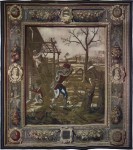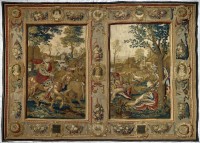 I’ve found a whole new subset of tapestry porn courtesy of the consistently entertaining Historic Royal Palaces YouTube channel: tapestry washing! The tapestry in question is February, one of a series depicting the 12 months that was commissioned by the future Charles I (then Prince of Wales) from the Mortlake Tapestry Works in 1623. At 13 feet (398 centimeters) by 11’4″ (347 cm), it’s one of the largest tapestries in the collection of Hampton Court Palace and, like the ones in the Kunsthistorisches Museum we just oogled, is in a perpetually delicate state of conservation.
I’ve found a whole new subset of tapestry porn courtesy of the consistently entertaining Historic Royal Palaces YouTube channel: tapestry washing! The tapestry in question is February, one of a series depicting the 12 months that was commissioned by the future Charles I (then Prince of Wales) from the Mortlake Tapestry Works in 1623. At 13 feet (398 centimeters) by 11’4″ (347 cm), it’s one of the largest tapestries in the collection of Hampton Court Palace and, like the ones in the Kunsthistorisches Museum we just oogled, is in a perpetually delicate state of conservation.
Washing any antique tapestry is a conservation challenge, and washing the monumental ones is an immense logistical challenge as well. Hampton Court Palace experts have built a custom tapestry bath to handle their giant textiles. They use de-ionised water, a special detergent and a phalanx of lab-coated conservators to ever so gently lower the tapestry into a shallow pool where it’s washed with utmost tenderness and care. Once the tapestry is rinsed, conservators dry it by blotting with towels and then surround it with fans. Watch the magic happen:
That video seriously has everything. It combines my childhood adoration of carwashes with my adult adoration of antique textiles and the nitty-gritty of conservation that usually takes place exclusively behind the scenes. Also, I love how gently the conservators sponge the surface like they’re bathing a gigantic wool, silk, gold and silver baby in a massive bassinet.
 February really is a baby compared to one its siblings: the tapestry of May and June which is a double-wide, each month represented in vertical sections divided by a border. It’s more than 13 feet high and almost 16 feet wide. I’d love to see that one gingerly unrolled into its megabath.
February really is a baby compared to one its siblings: the tapestry of May and June which is a double-wide, each month represented in vertical sections divided by a border. It’s more than 13 feet high and almost 16 feet wide. I’d love to see that one gingerly unrolled into its megabath.
The series was commissioned by Charles I when he was still Prince of Wales. His father James I established the royal tapestry manufacturers in 1619, inspired by Henry IV of France who had founded the first royal tapestry workshop in Paris in 1607 as part of a program to revive production of French luxury goods that had declined so precipitously during the Wars of Religion. James enlisted Sir Francis Crane to set up the shop and then scoured the Low Countries for the greatest tapestry weavers he could poach. Apparently James missed his calling as a recruiter, because 50 top weavers were ensconced in the new workshop on the Thames at Mortlake, just outside of London, before the Netherlandish authorities knew they were gone. They didn’t hear about it until the ambassador reported in a 1620 letter that the tapestry manufacturing capabilities of the Low Countries were threatened by the alarming number of their best weavers suddenly in London.
Aided by apprentices James insisted be selected from London’s city hospitals/orphanages so that pauper boys could learn a lucrative trade instead of living in penury the rest of their lives, the Flemish weavers hit the ground running. They set to work on royal commissions from the king, Prince Charles, James’ favorite the Duke of Buckingham and other aristocratic buyers. Charles ordered the Twelve Months set from Madrid where he was engaged in very controversial negotiations to marry Infanta Maria Anna of Spain. He wrote to his people in London that they should pay £500 for the set, quite a modest sum considering that in the same letter he directed them to pay £700 for some tapestry cartoons from Italy.
The Prince of Wales became King Charles I in 1625 and patronized the Mortlake Tapestry Works even more than his father had. He subsidized it to the tune of thousands of pounds a year as well as commissioning some of the greatest tapestries in the royal collection. It was Charles I who bought the Raphael cartoons and commissioned tapestry designs from masters like Rubens and Van Dyke. After Sir Francis Crane’s death in 1637, the tapestry works became official property of the crown.